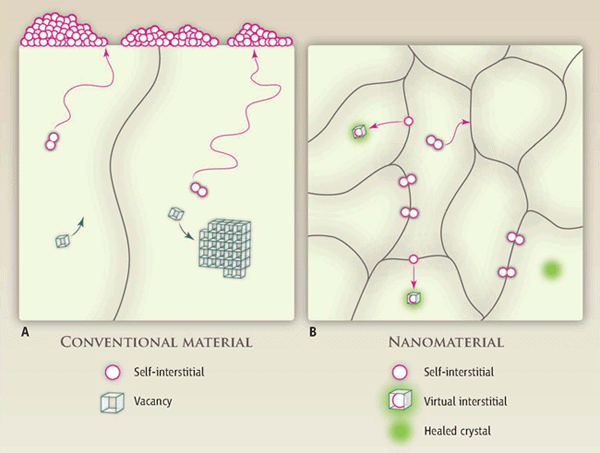Materials for nuclear reactors
The limiting factor for the safe operation of a nuclear reactor is the deterioration of the materials from which it is constructed. Radiation damage is an important source of this deterioration. The ability of a material to resist radiation damage is determined by how well the microstructure can remove vacancies and interstitial defects in equal numbers. However, the exact processes by which this happens are poorly understood, and the search for promising materials has been largely heuristic.

Diagram authored by Prof Graeme Ackland. © The University of Edinburgh
In addition to existing fission power, the possibility of building fusion power stations, producing energy in the form of vast numbers of energetic neutrons and alpha particles, is firmly back on the agenda. But a key problem remains: What will they be built of?
This problem is far from simple, because neutrons damage any structural material. This is an issue even for conventional fission power stations, but is particularly problematic for fusion, where the neutron fluxes are much greater and sensitive equipment (such as magnets or lasers) is required. Moreover, alpha particles turn into helium atoms, which causes further problems. Radiation damage is measured in "displacements per atom" (dpa); that is, how often each atom is blasted away from its crystal site. A fusion reactor will produce many hundreds of dpa over its lifetime: Every atom in its structure will be removed hundreds of times. Materials must be found that can self-heal this extent of damage.
Furthermore, radiation damage is a non-equilibrium process: the time and dose dependence of radiation damage are not simply related. There is no way to determine the effect of 40 years worth of radiation from experiments of shorter length. Because of this huge uncertainty, the first generation of power stations had fairly conservative lifetime estimates; it now transpires that it is safe to renew their licences.
There is no doubt that there are many better materials for reactor construction than those used at present. However, because of the experimental difficulties *proving* this is more difficult. We use computer simulation to uncover the atomic-level processes involved in radiation damage. There are many aspects to the research:
Density Functional Theory calculations use quantum mechanics to determine the precise interactions between vacancies, interstitials and impurities.
Interatomic potentials provide a simplified description of the forces between atoms.
Molecular dynamics determines the processes which produce defects in radiation damage, the rate at which these defects are produced, move, combined and heal.
Kinetic Monte Carlo determines how a material with these defects will age over a timescale of years.
Opportunities to study any of these four areas to PhD level in the group of Prof.Ackland exist at Edinburgh within the DTC in Condensed Matter Physics.
Material for fusion reactors
The extreme operating conditions of future tokamak fusion reactors demand durable materials for the chamber walls and in particular for the diverter at the base of the chamber, where the He and heat generated by the reaction are extracted. These conditions can induce pronounced radiation damage in materials, and in addition both physical and chemical erosion may occur. Erosion of the plasma-facing reactor materials should also be minimised to avoid contaminating or cooling the plasma. Any dusty or porous by-products from etching may retain tritium in parts of the reactor where it is not easily removed, while the dust created by such processes could additionally represent a safety issue. Carbon is a low Z material which limits the plasma cooling by line radiation, and it is electrically and thermally conductive, but it is readily attacked by hydrogen (deuterium or tritium in a fusion process) and is sputtered by energetic species. The erosion and dust formation rates are too high and it is also susceptible to neutron damage. Nonetheless, because of its good power handling capabilities without melting, it has been used in different forms for some of the most demanding parts of tokamaks.
Results from Heriot-Watt’s £1.4m EPSRC project (EP/E035868/1) “Putting Next Generation Fusion Materials on the Fast Track” have demonstrated that diamond coatings present lower erosion rates, less plasma contamination and lower fuel retention than other currently used plasma-facing materials. In conjunction with collaborators at the Culham Centre for Fusion Energy, Heriot-Watt has prepared diamond coatings on special substrates for testing in tokamaks worldwide: MAST (UK), DIII-D (USA), TEXTOR (Germany), in the high density plasma systems PISCES-B (USA) and Pilot-PSI (The Netherlands), and the high power electron beam facility JUDITH (Germany). These tests have shown no delamination of diamond coatings, no graphitisation, and merely the creation of a 10 nm amorphous layer at the diamond surface after exposure to fusion-type plasma (in agreement with molecular dynamics simulations carried out by our collaborators at UCL). Thus post-exposure analyses have confirmed that diamond provides greater resistance to these plasma conditions than does graphite, hence bringing carbon in the form of diamond into consideration for the most extreme parts of tokamaks.